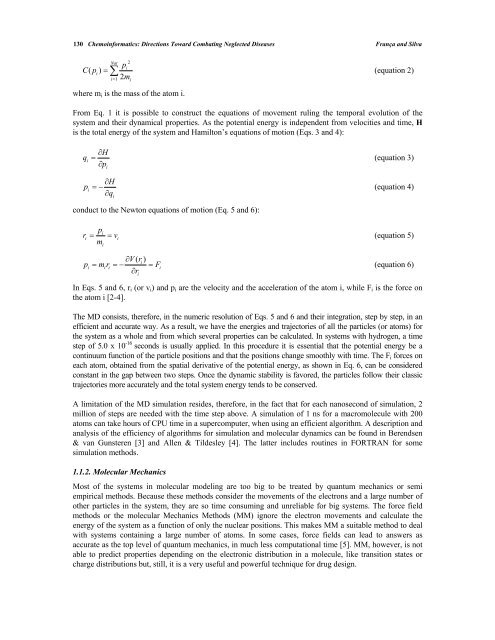chapter 1 - Bentham Science
chapter 1 - Bentham Science
chapter 1 - Bentham Science
You also want an ePaper? Increase the reach of your titles
YUMPU automatically turns print PDFs into web optimized ePapers that Google loves.
130 Chemoinformatics: Directions Toward Combating Neglected Diseases França and Silva<br />
C( p )<br />
i<br />
Nat<br />
p<br />
2<br />
i<br />
2m<br />
i1 i<br />
where mi is the mass of the atom i.<br />
(equation 2)<br />
From Eq. 1 it is possible to construct the equations of movement ruling the temporal evolution of the<br />
system and their dynamical properties. As the potential energy is independent from velocities and time, H<br />
is the total energy of the system and Hamilton’s equations of motion (Eqs. 3 and 4):<br />
H<br />
qi<br />
<br />
p<br />
H<br />
pi<br />
<br />
q<br />
i<br />
i<br />
conduct to the Newton equations of motion (Eq. 5 and 6):<br />
pi<br />
ri vi<br />
m<br />
i<br />
V(<br />
ri)<br />
pi mr i i Fi<br />
r<br />
i<br />
(equation 3)<br />
(equation 4)<br />
(equation 5)<br />
(equation 6)<br />
In Eqs. 5 and 6, ri (or vi) and pi are the velocity and the acceleration of the atom i, while Fi is the force on<br />
the atom i [2-4].<br />
The MD consists, therefore, in the numeric resolution of Eqs. 5 and 6 and their integration, step by step, in an<br />
efficient and accurate way. As a result, we have the energies and trajectories of all the particles (or atoms) for<br />
the system as a whole and from which several properties can be calculated. In systems with hydrogen, a time<br />
step of 5.0 x 10 -16 seconds is usually applied. In this procedure it is essential that the potential energy be a<br />
continuum function of the particle positions and that the positions change smoothly with time. The Fi forces on<br />
each atom, obtained from the spatial derivative of the potential energy, as shown in Eq. 6, can be considered<br />
constant in the gap between two steps. Once the dynamic stability is favored, the particles follow their classic<br />
trajectories more accurately and the total system energy tends to be conserved.<br />
A limitation of the MD simulation resides, therefore, in the fact that for each nanosecond of simulation, 2<br />
million of steps are needed with the time step above. A simulation of 1 ns for a macromolecule with 200<br />
atoms can take hours of CPU time in a supercomputer, when using an efficient algorithm. A description and<br />
analysis of the efficiency of algorithms for simulation and molecular dynamics can be found in Berendsen<br />
& van Gunsteren [3] and Allen & Tildesley [4]. The latter includes routines in FORTRAN for some<br />
simulation methods.<br />
1.1.2. Molecular Mechanics<br />
Most of the systems in molecular modeling are too big to be treated by quantum mechanics or semi<br />
empirical methods. Because these methods consider the movements of the electrons and a large number of<br />
other particles in the system, they are so time consuming and unreliable for big systems. The force field<br />
methods or the molecular Mechanics Methods (MM) ignore the electron movements and calculate the<br />
energy of the system as a function of only the nuclear positions. This makes MM a suitable method to deal<br />
with systems containing a large number of atoms. In some cases, force fields can lead to answers as<br />
accurate as the top level of quantum mechanics, in much less computational time [5]. MM, however, is not<br />
able to predict properties depending on the electronic distribution in a molecule, like transition states or<br />
charge distributions but, still, it is a very useful and powerful technique for drug design.

















